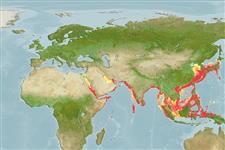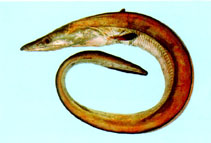Muraenesox cinereus (Forsskål, 1775)
Daggertooth pike conger
把你的觀察加入 Fish Watcher
| Native range | All suitable habitat | Point map | Year 2050 |

|
| This map was computer-generated and has not yet been reviewed. |
| Muraenesox cinereus AquaMaps Data sources: GBIF OBIS |
上傳你的 相片 和 影像
Pictures | Stamps, coins, misc. | Google 影像Muraenesox cinereus
Picture by Khalaf, M.A.
Pictures | Stamps, coins, misc. | Google 影像Muraenesox cinereus
Picture by Khalaf, M.A.
Malaysia country information
Common names:
Belut, Daggertooth pike conger, Indong
Occurrence: native
Salinity: freshwater
Abundance: | Ref:
Importance: minor commercial | Ref: FAO, 1994
Aquaculture: | Ref:
Regulations: | Ref:
Uses: no uses
Comments:
National Checklist:
Country Information: https://www.cia.gov/library/publications/resources/the-world-factbook/geos/my.html
National Fisheries Authority:
Occurrences: Occurrences Point map
Main Ref: Mohsin, A.K.M., M.A. Ambak and M.N.A. Salam, 1993
National Database:
Occurrence: native
Salinity: freshwater
Abundance: | Ref:
Importance: minor commercial | Ref: FAO, 1994
Aquaculture: | Ref:
Regulations: | Ref:
Uses: no uses
Comments:
National Checklist:
Country Information: https://www.cia.gov/library/publications/resources/the-world-factbook/geos/my.html
National Fisheries Authority:
Occurrences: Occurrences Point map
Main Ref: Mohsin, A.K.M., M.A. Ambak and M.N.A. Salam, 1993
National Database:
Common names from other countries
分類 / Names 俗名 | 同種異名 | Catalog of Fishes(屬, 種) | ITIS | CoL | WoRMS | Cloffa
Teleostei > Anguilliformes (Eels and morays) 鰻鱺目 (Eels and morays) > Muraenesocidae (Pike congers) 海鰻科 (Pike congers)
Etymology: Muraenesox: Latin, muraena = morey eel + Esox, old name for pike (Ref. 45335).
More on author: Forsskål.
Etymology: Muraenesox: Latin, muraena = morey eel + Esox, old name for pike (Ref. 45335).
More on author: Forsskål.
Environment: milieu / climate zone / depth range / distribution range 生態學
海洋; 淡水; 半鹹淡水 居於水底的; 海洋洄游的; 深度上下限 ? - 800 m (Ref. 100719), usually ? - 300 m (Ref. 9942). 亞熱帶的; 47°N - 4°S, 30°E - 143°E (Ref. 54598)
分布 國家 | FAO區域 | 生態系 | 發現紀錄 | Point map | 簡介 | Faunafri
Indo-West Pacific: Red Sea, Persian Gulf, west coast of India, and Sri Lanka to Fiji and Tuvalu (Ref. 12596), north to Japan and Korea, south to the Arafura Sea (Ref. 9819) and northern Australia. Migrated to the Mediterranean via the Suez Canal (Ref. 6724).
印度-西太平洋: 紅海,波斯灣,印度西岸與斯里蘭卡到斐濟與吐瓦魯 (參考文獻 12596),北至日本與韓國, 南至阿拉弗拉海 (參考文獻 9819) 與澳洲北部。 經由蘇伊士運河迴游到地中海了。 (參考文獻 6724)
印度-西太平洋: 紅海,波斯灣,印度西岸與斯里蘭卡到斐濟與吐瓦魯 (參考文獻 12596),北至日本與韓國, 南至阿拉弗拉海 (參考文獻 9819) 與澳洲北部。 經由蘇伊士運河迴游到地中海了。 (參考文獻 6724)
大小 / 重量 / 年齡
Maturity: Lm ? range ? - ? cm
Max length : 220 cm TL 雄魚/尚未辨別雌雄; (Ref. 559); common length : 80.0 cm TL 雄魚/尚未辨別雌雄; (Ref. 3397); 最大年齡: 15 年 (Ref. 72462)
Max length : 220 cm TL 雄魚/尚未辨別雌雄; (Ref. 559); common length : 80.0 cm TL 雄魚/尚未辨別雌雄; (Ref. 3397); 最大年齡: 15 年 (Ref. 72462)
簡短描述 檢索表 | 型態特徵 | 形態測量圖
背棘 (總數) : 0; 臀棘: 0; 脊椎骨: 145 - 159. Snout long; eye diameter 2-2.5 times in snout length; posterior nostrils much closer to eyes than to anterior nostrils; mouth very large; teeth generally large and conspicuous (Ref. 4832). Head broader, interorbital about 8 times in head; lateral-line pores before anus 44-47; dorsal-fin rays before anus 66-78; vertebrae 145-159 (Ref. 9830).
吻長的; 倍分之一吻長的眼直徑 2-2.5; 後鼻孔更靠近眼超過對前鼻孔; 嘴非常大的; 齒通常大而顯著的.(參考文獻 4832) 頭部比較寬的, 眼間骨大約 8 倍頭長比率; 側線孔在肛門前 44-47; 背鰭鰭條在肛門前 66-78; 脊椎骨 145-159.(參考文獻 9830)
吻長的; 倍分之一吻長的眼直徑 2-2.5; 後鼻孔更靠近眼超過對前鼻孔; 嘴非常大的; 齒通常大而顯著的.(參考文獻 4832) 頭部比較寬的, 眼間骨大約 8 倍頭長比率; 側線孔在肛門前 44-47; 背鰭鰭條在肛門前 66-78; 脊椎骨 145-159.(參考文獻 9830)
Occurs from the littoral zone to the upper bathy-benthic region (Ref. 9942, 11230). Inhabits soft bottoms (Ref. 11230), also found in estuaries. Sometimes enters freshwater environment (Ref. 9987). Feeds on small bottom fishes and crustaceans. Captured and cultured for fishery in Japan. Marketed mainly fresh (Ref. 7238). Also used as bait for shark fishing (Ref. 2872). Also caught by bag (dol) nets. Used in Chinese medicine (Ref. 12166).
生存於海濱的區域到上面的 bathy-底棲的區域。 (參考文獻 9942,11230) 棲息於軟質底部 (參考文獻 11230), 也發現於河口。 有時進入淡水的環境。 (參考文獻 9987) 吃小的底層魚類與甲殼動物。 為日本水產業捕獲了而且養殖。 生鮮地主要地在市場上銷售。 (參考文獻 7238) 也對於鯊魚釣魚的用來當魚餌.(參考文獻 2872) 也被袋網捕獲。 被用於中藥材了。 (參考文獻 12166)
生存於海濱的區域到上面的 bathy-底棲的區域。 (參考文獻 9942,11230) 棲息於軟質底部 (參考文獻 11230), 也發現於河口。 有時進入淡水的環境。 (參考文獻 9987) 吃小的底層魚類與甲殼動物。 為日本水產業捕獲了而且養殖。 生鮮地主要地在市場上銷售。 (參考文獻 7238) 也對於鯊魚釣魚的用來當魚餌.(參考文獻 2872) 也被袋網捕獲。 被用於中藥材了。 (參考文獻 12166)
Life cycle and mating behavior 成熟度 | 繁殖 | 產卵場 | 卵 | 孕卵數 | 仔魚
印度-西太平洋: 紅海,波斯灣,印度西岸與斯里蘭卡到斐濟與吐瓦魯 (參考文獻 12596),北至日本與韓國, 南至阿拉弗拉海 (參考文獻 9819) 與澳洲北部。 經由蘇伊士運河迴游到地中海了。 (參考文獻 6724)
主要參考資料
Upload your references | 參考文獻 | 合作者 | 合作者
Masuda, H., K. Amaoka, C. Araga, T. Uyeno and T. Yoshino, 1984. The fishes of the Japanese Archipelago. Vol. 1. Tokai University Press, Tokyo, Japan. 437 p. (text). (Ref. 559)
對人類具威脅
無害處的
人類使用
漁業: 高經濟性; 養殖: 商業性; 游釣魚種: 是的; 誘餌: occasionally
更多資訊
Population dynamics
成長參數
Max. ages / sizes
Length-weight rel.
Length-length rel.
長度-頻率
Mass conversion
入添量
豐度
成長參數
Max. ages / sizes
Length-weight rel.
Length-length rel.
長度-頻率
Mass conversion
入添量
豐度
Anatomy
鰓區
Brain
Otolith
鰓區
Brain
Otolith
Physiology
Body composition
Nutrients
耗氧量
游泳類型
游泳速度
Visual pigments
Fish sound
Diseases & Parasites
Toxicity (LC50s)
Body composition
Nutrients
耗氧量
游泳類型
游泳速度
Visual pigments
Fish sound
Diseases & Parasites
Toxicity (LC50s)
工具
E-book | 野外調查 | 檢索表 | 長度- 頻率 Wizard | 生活- 歷史的工具 | 分布圖 | Classification Tree
| Catch-MSY |
特別的報告
下載 XML
網路資源
Alien/Invasive Species database | Aquatic Commons | BHL | Cloffa | Websites from users | 檢查 FishWatcher | CISTI | Catalog of Fishes(屬, 種) | DiscoverLife | ECOTOX | Faunafri | Fishtrace | GenBank(基因組, 核甘) | GloBI | GOBASE | | Google Books | Google Scholar | Google | IGFA World Record | MitoFish | 國家資料庫 | Otolith Atlas of Taiwan Fishes | PubMed | Reef Life Survey | Scirus | SeaLifeBase | 樹狀分類階層 | Wikipedia(去, 搜尋) | World Records Freshwater Fishing | 動物學的記錄
Estimates based on models
Preferred temperature (Ref. 115969): 11.6 - 23.2, mean 17.4 (based on 401 cells).
Phylogenetic diversity index (Ref. 82804): PD50 = 0.6250 [Uniqueness, from 0.5 = low to 2.0 = high].
Bayesian length-weight: a=0.00427 (0.00162 - 0.01121), b=3.06 (2.84 - 3.28), in cm Total Length, based on LWR estimates for this (Sub)family-body shape (Ref. 93245).
營養階層 (Ref. 69278): 4.4 ±0.67 se; based on food items.
回復力 (Ref. 120179): 中等的, 族群倍增時間最少 1.4 - 4.4年 (Tmax=15; K=0.19-0.33; Min Rel Fec=153).
Prior r = 0.57, 95% CL = 0.37 - 0.85, Based on 3 data-limited stock assessments.
Fishing Vulnerability (Ref. 59153): High vulnerability (62 of 100).
Climate Vulnerability (Ref. 125649): Very high vulnerability (85 of 100).




